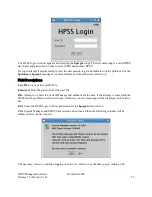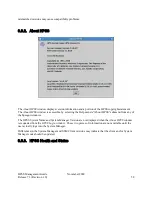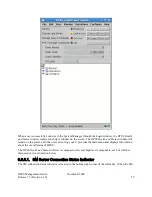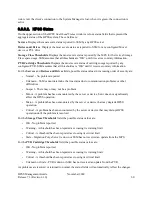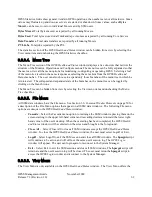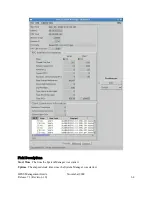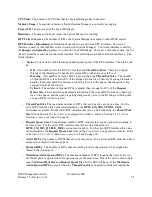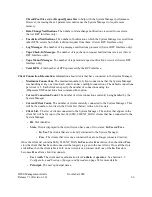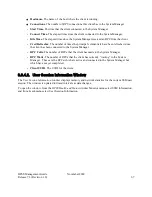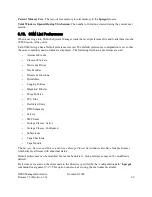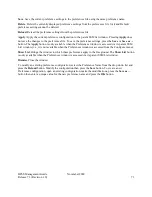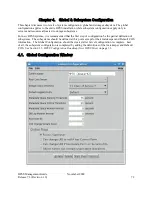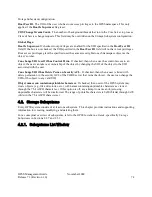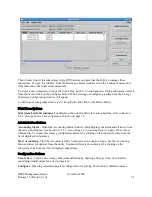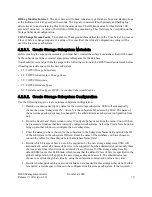
CPU Time.
The amount of CPU time that the System Manager has consumed.
Memory Usage.
The amount of memory that the System Manager is currently occupying.
Process ID.
The process id of the System Manager.
Hostname.
The name of the host where the System Manager is running.
RPC Calls to Servers.
The number of RPCs the System Manager has made to other HPSS servers.
RPC Interface Information.
Information about the server and client RPC interfaces. The server
interface is used by other HPSS servers to contact the System Manager. The client interface is used by
the
hpssgui
and
hpssadm
programs to contact the System Manager. There are 2 columns of data, one for
the server interface and one for the client interface. Not all fields are available for both interfaces. The
fields include:
•
Status.
Current status of the thread pool and request queue of the RPC interface. The Status can
be:
•
OK
– The number of Active RPCs is less than the
Thread Pool Size
. There are enough
threads in the thread pool to handle all current RPCs with spare ones left over.
•
Warning
– The number of Active RPCs is greater than the
Thread Pool Size
. The number
of Queued RPCs is less than 90% of the Request Queue Size.
There aren't enough threads to
handle all the current RPCs and some are having to wait in the queue, but the queue is big
enough to hold all the waiters.
•
Critical
– The number of Queued RPCs is greater than or equal to 90% of the
Request
Queue
Size
. There aren't enough threads to handle all the current RPCs, some are having to
wait in the queue, and the queue is getting dangerously close to overflowing, at which point
any new RPCs will be rejected.
•
Thread Pool Size.
The maximum number of RPCs that can be active at any one time. For the
server RPC interface this value is determined by the
HPSS_SM_SRV_TPOOL_SIZE
environment variable. For the client RPC interface this value is determined by the
Thread Pool
Size
field defined on the
Core Server Configuration
window. Refer to Section 5.1.1.2:
Error:
Reference source not found
on page 92.
•
Request Queue Size.
The maximum number of RPC requests that can be queued and waiting to
become active. For the server RPC interface this value is determined by the
HPSS_SM_SRV_QUEUE_SIZE
environment variable. For the client RPC interface this value
is determined by the
Request Queue Size
field on the
Core Server Configuration
window. Refer
to Section 5.1.1.2:
Error: Reference source not found
on page 92.
•
Active RPCs.
The number of RPCs that are currently active. To be active an RPC must have been
assigned to a thread in the thread pool.
•
Queued RPCs.
The number of RPCs that are waiting in the request queue to be assigned to a
thread in the thread pool.
•
Maximum Active/Queued RPCs
. The maximum number of RPC requests that were active (in
the thread pool) or queued (in the request queue) at the same time. This value can be used to help
tune the
Thread Pool Size
and
Request Queue Size
for the RPC interface. If the
Maximum
Active/Queued RPCs
is greater than the
Thread Pool Size
you might consider increasing the
HPSS Management Guide
November 2009
Release 7.3 (Revision 1.0)
65
Summary of Contents for RELEASE 7.3
Page 14: ...HPSS Management Guide November 2009 Release 7 3 Revision 1 0 14...
Page 195: ...HPSS Management Guide November 2009 Release 7 3 Revision 1 0 195...
Page 210: ...HPSS Management Guide November 2009 Release 7 3 Revision 1 0 210...
Page 215: ...HPSS Management Guide November 2009 Release 7 3 Revision 1 0 215...
Page 222: ...HPSS Management Guide November 2009 Release 7 3 Revision 1 0 222...
Page 266: ...HPSS Management Guide November 2009 Release 7 3 Revision 1 0 266...
Page 293: ...HPSS Management Guide November 2009 Release 7 3 Revision 1 0 293...
Page 367: ...HPSS Management Guide November 2009 Release 7 3 Revision 1 0 367...
Page 372: ...HPSS Management Guide November 2009 Release 7 3 Revision 1 0 372...
Page 384: ...HPSS Management Guide November 2009 Release 7 3 Revision 1 0 384...
Page 388: ...HPSS Management Guide November 2009 Release 7 3 Revision 1 0 388...







